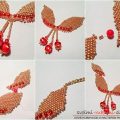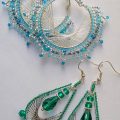
Master class with step-by-step photos on weaving necklaces of beads and agate.
This kind of jewelry, like a necklace or a necklacehas been known for many centuries. The ancient Egyptians, Greeks, Slavs, inhabitants of Mesopotamia wore these ornaments, as evidenced by archaeological finds in burials. Today, in order to become the owner of a beautiful necklace or necklace, it is absolutely not necessary to make a purchase in a jewelry store. More and more fans around the world are gaining jewelry. Bright and original jewelry craftsmen create from a variety of materials. And one of the most popular is the beads. This is a very ancient material for needlework and at the same time very young. Bright shades of non-dimming pieces of the rainbow help to weave incredible and original things. There are many fairy tales about the origin of beads. According to the Turkmen beliefs, beads are tears of beautiful girls. Beauties abducted and captivated in the cave an evil desert spirit - the devas. According to another legend, glass beads were born, thanks to the merchants from Phenicia. They sailed across the Mediterranean and stopped for the night on a deserted sandy beach. There were no stones nearby, and they took advantage of pieces of natural soda, which they brought for trade, and surrounded it with a hearth. In the morning in the coals from the fire the merchants discovered an ingot, transparent and durable - glass. In this article, several master classes for creating necklaces and necklaces from this wonderful material will be offered. The first master class with step-by-step photos is dedicated to creating a necklace of beads and agate in mystical dark tones. 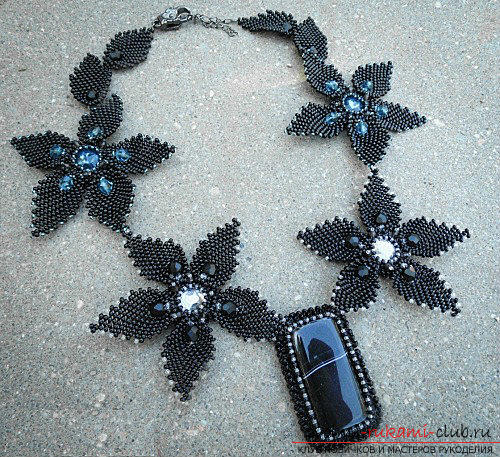 It will take:
It will take:
- Gray rhinestones (11 mm) 2 pcs .;
- Turquoise twills (14 mm) 2 pcs .;
- Rectangular agate bead or carcasson of black color 1 pc .;
- Beads from glass faceted turquoise color (6 mm) 10 pcs .;
- Beads made of plastic, black faceted (3 mm) 20 pcs .;
- Beads 15/0 turquoise color and transparent;
- Beads 10/0 in black;
- The line is 0.15 mm;
- Needle number 10;
- Fittings for necklaces (rings, carbines, chains) in black;
- A piece of leather for the wrong side;
- Glue;
- A piece of felt.
To begin with, you need to carve the central stone. Gently glue it to a piece of felt and cut the workpiece, stepping back from the stone 5 mm from all sides.  Strip the workpiece with black beads usingseam "needle back". From the wrong side, leave a small tail. Dial 2 beads and bring the needle to the underside immediately after the beads. Bring the needle between the two beads on the front side and thread the needle into the second one. String another 2 beads and repeat the manipulation. In the first row, you need to make an even number of beads.
Strip the workpiece with black beads usingseam "needle back". From the wrong side, leave a small tail. Dial 2 beads and bring the needle to the underside immediately after the beads. Bring the needle between the two beads on the front side and thread the needle into the second one. String another 2 beads and repeat the manipulation. In the first row, you need to make an even number of beads. 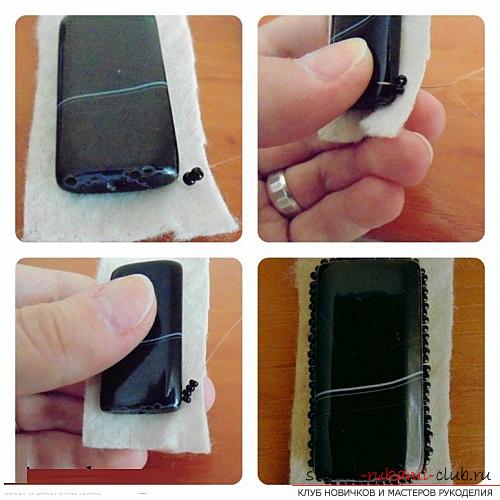 Pass the needle in all the beads and tighten the row. Then pull the needle out of any beads, thread 1 bead and pass a needle through one bead, repeat. Should be a number of both in mosaic weaving.
Pass the needle in all the beads and tighten the row. Then pull the needle out of any beads, thread 1 bead and pass a needle through one bead, repeat. Should be a number of both in mosaic weaving. 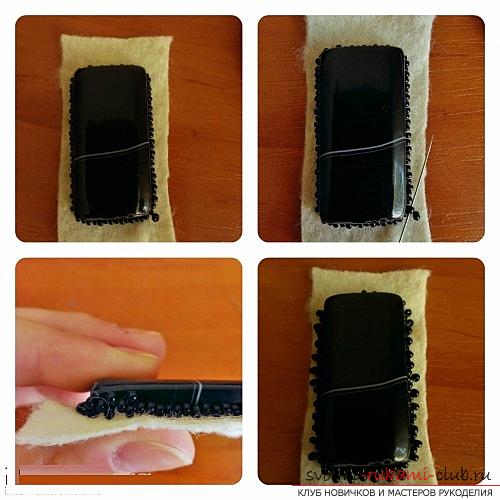 In the third row the line goes out of the serving bead, strings 1 bead and passes the line to the next protruding bead.
In the third row the line goes out of the serving bead, strings 1 bead and passes the line to the next protruding bead. 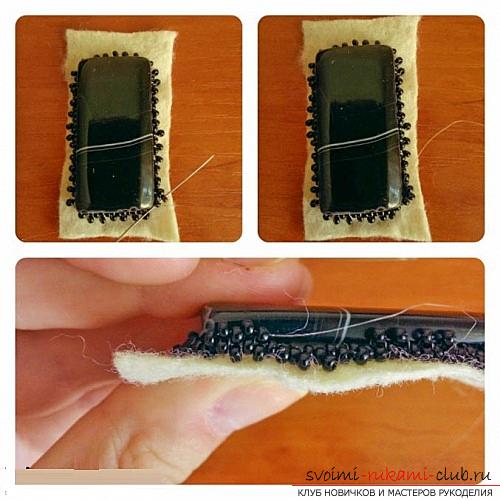 The next two rows of weaving are similar to the third. The last row weave from the transparent beads and tighten so that the stone is firmly entrenched. Skip the line through the whole row again, pull it to the wrong side of the tail, which was left in the beginning. Tie a knot and fuse with a match or a cigarette lighter. Trim the edges of the felt.
The next two rows of weaving are similar to the third. The last row weave from the transparent beads and tighten so that the stone is firmly entrenched. Skip the line through the whole row again, pull it to the wrong side of the tail, which was left in the beginning. Tie a knot and fuse with a match or a cigarette lighter. Trim the edges of the felt. 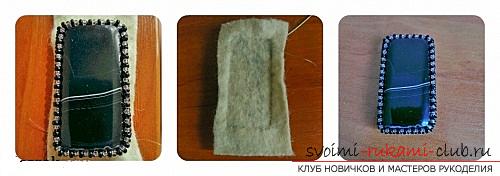 Glue the workpiece to a piece of leather. Leave around 5 mm perimeter. In order to trim the edge of the fishing line to withdraw from the beads of the second row (marked with a red circle in the photo). Collect 2 beads and pass the needle with a fishing line into the same hole from which the needle came out. Prick the skin gently. Pass the series along the perimeter.
Glue the workpiece to a piece of leather. Leave around 5 mm perimeter. In order to trim the edge of the fishing line to withdraw from the beads of the second row (marked with a red circle in the photo). Collect 2 beads and pass the needle with a fishing line into the same hole from which the needle came out. Prick the skin gently. Pass the series along the perimeter. 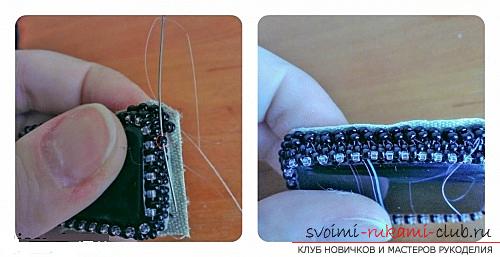 Excess skin to cut. The second row of skin will consist of 3 beads in a stitch. The line comes out of the upper bead of the first row, strung 3 beads, and from the wrong side, thread a needle with a fishing line into the hole already available from the first row.
Excess skin to cut. The second row of skin will consist of 3 beads in a stitch. The line comes out of the upper bead of the first row, strung 3 beads, and from the wrong side, thread a needle with a fishing line into the hole already available from the first row. 
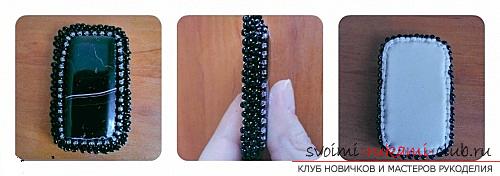 The next stage is the braiding of rhinestones. The workpiece, as in the previous case, should be glued to the felt, trimmed and braided with beads, then glued to the skin and sewed again. In the last row of the skin, instead of three beads, take two. A scheme is proposed for the leaves. Use transparent and black beads. Transparent in the diagram is indicated in red.
The next stage is the braiding of rhinestones. The workpiece, as in the previous case, should be glued to the felt, trimmed and braided with beads, then glued to the skin and sewed again. In the last row of the skin, instead of three beads, take two. A scheme is proposed for the leaves. Use transparent and black beads. Transparent in the diagram is indicated in red.  The work is carried out in one thread from the edge to the center. In this master class, the leaves are woven into 5 denticles. You can do as much as you want, count the number of beads marked in red. You need 5 leaves. Tail of the leaf to connect as in the photo. Attach them to the rhinestone.
The work is carried out in one thread from the edge to the center. In this master class, the leaves are woven into 5 denticles. You can do as much as you want, count the number of beads marked in red. You need 5 leaves. Tail of the leaf to connect as in the photo. Attach them to the rhinestone. 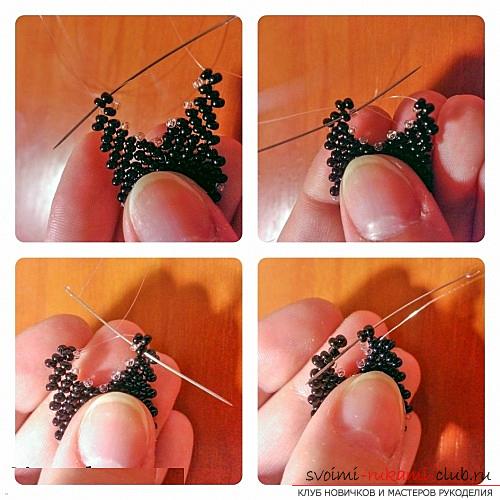
 For the last sheet, you need to take a largecut line, because the round end of the leaf is attached to the rhinestone, sharp to the rectangular central stone and the same tail, you need to attach the beads to the workpiece. Follow the directions on the photo. The line leaves the bead in a red circle.
For the last sheet, you need to take a largecut line, because the round end of the leaf is attached to the rhinestone, sharp to the rectangular central stone and the same tail, you need to attach the beads to the workpiece. Follow the directions on the photo. The line leaves the bead in a red circle. 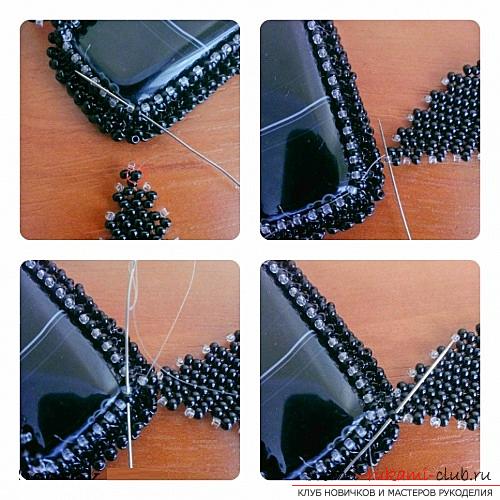 First, sew a large bead of black color. The beginning of the work is indicated by a red circle. Continue on the photo.
First, sew a large bead of black color. The beginning of the work is indicated by a red circle. Continue on the photo. 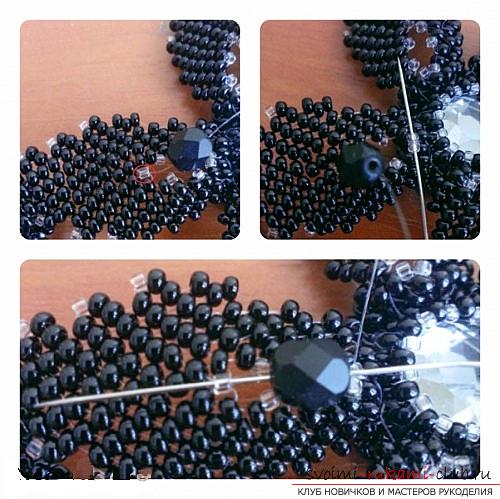 The next step is sewing a small beadblack color. The initial bead is marked in red. Pass through it a fishing line, thread a small bead of black color and 1 transparent bead and act as indicated in the photo.
The next step is sewing a small beadblack color. The initial bead is marked in red. Pass through it a fishing line, thread a small bead of black color and 1 transparent bead and act as indicated in the photo.  Perform all the steps for the remaining petals and the second flower.
Perform all the steps for the remaining petals and the second flower. 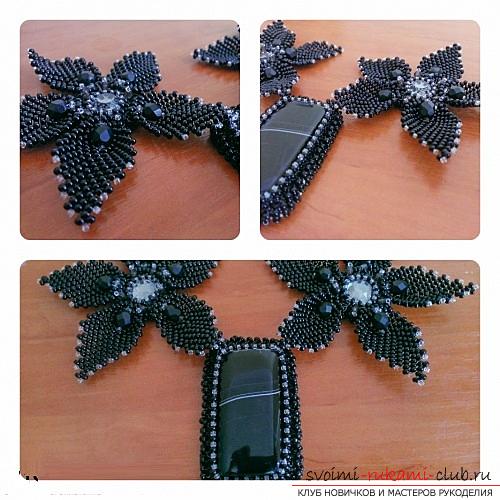 The next steps are the flowers from the rhyolite. They will also need 2 pieces. For beginners and those who are not friends with the mosaic weave, in this master class an alternative way of braiding is suggested. To do this, fold a small piece of felt four times and cut off the corner (see photo). Then, in this hole, attach the tailings with the wrong side, circle it around the perimeter and embroider the first circle as before.
The next steps are the flowers from the rhyolite. They will also need 2 pieces. For beginners and those who are not friends with the mosaic weave, in this master class an alternative way of braiding is suggested. To do this, fold a small piece of felt four times and cut off the corner (see photo). Then, in this hole, attach the tailings with the wrong side, circle it around the perimeter and embroider the first circle as before.  Sheath and braid, as well as rhinestones.
Sheath and braid, as well as rhinestones. 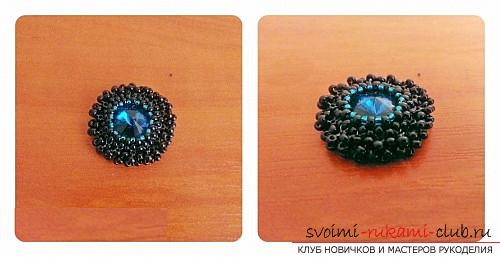 Leaves for the flower, which in the heartRivoli weave like a leaf for a rhinestone, but instead of a transparent bead take turquoise. Connect the round ends of the petals to the rhyolite, and sharp with the sharp ends of the petals with rhinestone. To achieve the desired length, it is necessary to weave 2 more leaves according to the petal pattern. Weave the beads in black. The round end of the leaf is attached to the side of the leaf below. The beginning of the work is circled in a red circle.
Leaves for the flower, which in the heartRivoli weave like a leaf for a rhinestone, but instead of a transparent bead take turquoise. Connect the round ends of the petals to the rhyolite, and sharp with the sharp ends of the petals with rhinestone. To achieve the desired length, it is necessary to weave 2 more leaves according to the petal pattern. Weave the beads in black. The round end of the leaf is attached to the side of the leaf below. The beginning of the work is circled in a red circle.  On the last leaves take a piece of fishing line more. It is necessary to attach beads, as in flowers. Instead of the last bead, attach a ring from the sharp edge.
On the last leaves take a piece of fishing line more. It is necessary to attach beads, as in flowers. Instead of the last bead, attach a ring from the sharp edge.  Attach a carbine clip and chain to them, and the necklace is ready.
Attach a carbine clip and chain to them, and the necklace is ready. 

